| URLs in this document have been updated. Links enclosed in {curly brackets} have been changed. If a replacement link was located, the new URL was added and the link is active; if a new site could not be identified, the broken link was removed. |
Electronic Resources Reviews
Web of Science and Scopus: Current Features and Capabilities
Supervisor, Science and Technology Information Services
R.E. Gibson Library & Information Center
The Johns Hopkins University Applied Physics Laboratory
Laurel, Maryland
Susan.Fingerman@jhuapl.edu
Introduction
When Elsevier introduced Scopus in 2004, it attracted lots of attention. This was partly due to an enormous marketing effort on their part, and partly due to the fact that Scopus was the first major challenge to the supremacy of the Thomson ISI Web of Science (WoS) product, particularly for citation tracking. Since then, happily for researchers, the developers of each product have been leapfrogging each other with features, and new announcements and claims seem to be forthcoming every week.There have been numerous articles and analyses on the Scopus product alone (Fingerman 2005) and on comparisons between Scopus, the Web of Science and more recently Google Scholar (Bakkalbasi 2006; Burnham 2006; Dess 2006; Deis and Goodman 2005; Jacso 2004; Jacso 2005; LaGuardia 2005). I will leave descriptions of and opinions on the interfaces of each product to those authors and indeed to the preferences of the users. As with all things web, these interfaces change frequently and may have been redesigned by the time you read this review.
This article will focus on capabilities and features of each product, current as of October 2006, rather than on the itemization and comparison of subjective search results. Once again, those types of analysis were amply covered in the papers cited above. As many of the previous articles have also pointed out, much of the utility and beauty of these products are in the eye of the beholder and will satisfy different information requirements to different degrees. As Burnham states, "Neither database is inclusive, but complements each other." That is why the review title uses "and" instead of "vs." However, I will also pull out some of the caveats that I feel are particularly important.
Why Citation Tracking
Just a short detour to point out some reasons why citation tracking is important. The beauty of both Scopus and Web of Science is that they allow you to look forward in time as well as backward. Most researchers often look for the references cited BY a paper, but many do not realize that they can look FORWARD in time to see more recent works where an important paper is cited, or to see where their own works are continuing to be referenced.Citation tracking allows for tracking of your own influence, and therefore the influence of your organization. It allows you to track the development of a technology, which may be the basis for progress undreamt of when a paper is written. Citation tracking provides information on other organizations and authors who are doing similar work, potentially for collaboration, and identifies publications that cover similar topics. Finally, tracking back in time can find the seminal works in a field.
Provenance
Web of Science, which is part of the Web of Knowledge product from Thomson ISI, grew from the venerable Science Citation Index created by Eugene Garfield in the early 1960s. It started life as a citation tracking product.Scopus was created from records extracted from Elsevier databases such as Geobase, Biobase, Embase etc. and was then enhanced with citation information. An arduous process that may account for the fact that cited references are available only from 1996 on.
Breadth and Depth
Scopus burst on the research scene in 2004 claiming it had the biggest database with the most information. Web of Science rejoined with the claim of having the most depth and the most quality. Intense scrutiny has cast doubt on claims, so we'll look at some basic facts.Web of Science covers the peer-reviewed journal literature, over 8,000 titles, with a concentration on the sciences but with some (23%) social science and arts and humanities titles. Their selection of which titles to cover is influenced by the number of citations within those journals. The much debated "journal impact factor" is discussed on their site for those interested. There is also a focus on English language material, and a U.S. bias. Web of Science has started covering a few open access journals, though Scopus claims to cover 500 of these as well (Thomson 2006c).
The scarcity of conference proceedings and other types of sources in WoS has become a detriment for certain disciplines for this searcher. However, there are some work-arounds for adding other databases to the parent Web of Knowledge product, such as adding their Current Web Contents and Current Contents databases if you license those. ISI has recently launched a Proceedings database which we hope will be incorporated into Web of Science, though probably at additional cost, as was the case when the enhanced Derwent Innovations Index patent information was recently made available.
The Science Citation Index Expanded product covers back to 1900, however other slices of time can be purchased, from 1945 and from 1980 forward respectively. All citations are listed for a paper going back as far as 1900.
In addition to covering over 14,000 journals, Scopus includes books, conference proceedings, trade journals, web sites, reports and patents from the U.S., European and Japanese Patent Offices. This comprehensiveness is a great plus, especially for documents from the last decade.
As far as types of documents included (and sortable), both products contain editorials, letters, meeting or conference reviews and erratum as well as the typical articles type. Web of Science uniquely lists book and software reviews, Scopus business articles and short surveys.
True to the Scopus provenance, the life and health sciences and biological, agricultural and environmental sciences are most heavily represented in the database, followed by chemistry, physics, math and engineering, with a more modest representation of the social sciences, psychology and economics.
The Elsevier parentage also means that Scopus searches the web through the Scirus search engine. Scopus claims that over 50% of its journal titles are from Europe, the Middle East, and Africa. Also important is its coverage of pre-print servers such as arXive and Cogprints, since many scientists in certain disciplines such as astrophysics, astronomy and physics use those sources extensively.
Though Scopus has records dated well before 1996, the citations for a paper will only appear if dated from 1996 on. Scopus claims that its market research showed that most researchers were not interested in earlier dates, but also welcomes feedback on the topic. This "currency" is detrimental when tracking the development of a field, and may result in many fewer numbers of citations for the same paper found in Web of Science.
Under the Hood
Librarians like to know just what kind of 'animal' they're using. Here both of these sources seem to shine, with extensive Librarian pages, online tutorials, and other "finding aids." I use the word "seem" since we need to realize that each site may contain a bit of hyperbole. See the references in this paper for a perhaps more realistic picture.While both have numerous tutorials, I'd like to point out the particularly well done WoS recorded training (Thomson 2006d). For some reason, you cannot find these from the WoS home page, but only on the main ISI support site (Thomson 2006b).
Both products provide extensive background information on how they were created and why they cover what they do. Scopus has a 20-page HTML Content Coverage guide dated May 2006 that includes a link to the breakdown of their coverage by country, explanations of the content type they cover, and how far back they cover a specific discipline, i.e., engineering goes back to 1970, and more. (See caveats section at end of this review however.) (Scopus 2006a).
Both products provide extensive source lists that can be sliced and diced in many ways. WoS allows you to search for a journal by title, title words, ISSN; browse an alphabetical list; pull up a list by category; or see a list with changes in journal coverage. They also provide journal descriptions (scope notes) within the subject categories, and link directly to the publisher site. Scopus includes an open access title list and also indicates for which years it has partial or continuous coverage for a source.
Both products offer RSS feeds for information updates about new features. If you're a regular user I suggest you subscribe to these.
Indexing
WoS is a much more scholarly source than Scopus. This leads to some rather esoteric practices with authority files which can either make your day or lead to frustration. As we all know, authors vary widely in their expertise with or interest in the "proper" way to cite. Often poor or incorrect citations are repeated through the literature for many generations! Authors and institutions are randomly identified with abbreviations, initials, etc. WoS provides normalized indices for institutions, which means you should use their "approved" names in your searches or use some rather convoluted "work arounds" to find who or what you're looking for.This "variant" citation situation also comes into play when using the Cited Ref capability of WoS. It means that the number of citations from a General Search, which only returns records that have the ISI officially accepted (full) citation, could be greatly augmented in the Cited Ref search, which includes variant cites. See the Cited Reference searching recorded tutorial in the ISI training page (Thomson 2006a).
Thanks once again to competition, both sources have recently introduced "author finders" to solve the problems inherent in the search for that author named Smith, B., Chen L., etc. who may or may not be the author you are looking for or may or may not be located at a certain institution. Scopus information is in their Author Identifier page (Scopus 2006b). WoS has a recorded tutorial on their new products (as of July 2006) in the ISI training page and it includes information on their author finder (Thomson 2006b).
Search Refinement
One of the most revolutionary features that Scopus brought to online databases was its presentation of faceted indexing. I have to confess that when I first saw this at the Scopus rollout in NY in 2004, I found it quite distracting. I was assured by the earnest product manager demonstrating the product that this feature had been thoroughly tested in beta and its inclusion and presentation vetted by both librarians and researchers.These faceted lists of metadata that are now popping up in other Elsevier products, such as EI Village Compendex, have become some of the best features of these products, and a major delight to show in customer training.
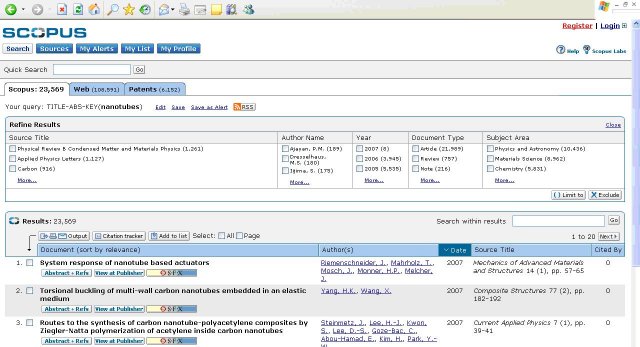
Figure 1: Scopus Refine Results example
WoS, not to be outdone, has gone a step further than Scopus in presenting metadata lists. Search results are not only analyzed and presented by author, source, year, document types, and subject as in Scopus, but also by countries/territories, language and institutions.
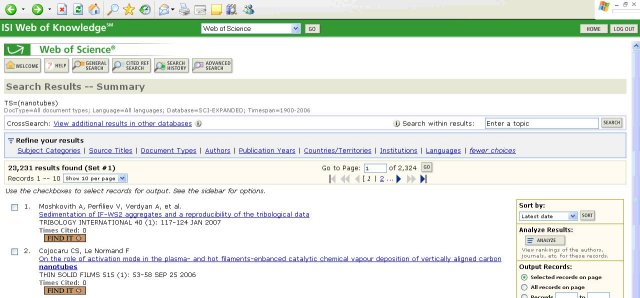
Figure 2: WoS Refine Results example
Utilizing Results
Both WoS and Scopus allow sorting results by the expected parameters (first author, relevance, cites etc.). Scopus has the useful feature of sorting by both ascending and descending dates and/or authors.Both products offer alerts, either as e-mails or RSS feeds, that let you know when there are new citations to a paper of interest. You must register for each product to utilize this feature, as well as the "saved searches" feature provided by each.
When doing citation searching, both products allow you to remove self-citations, which often can skew the number of results. The methodology for each is a bit clunky, but it is do-able.
Both products allow utilization of a link resolver, if you are fortunate enough to have this helpful software that links out to the full text of licensed content. Scopus also has a neat "Library Catalog" icon that links to the source listing in your local catalog.
Both products allow for exporting to a bibliographic tool such as RefWorks, EndNote etc. Scopus includes a convenient tab for creating a bibliography, in many journal formats, right from your selected/marked list of results records.
Analysis of Search Results
To our benefit, the analysis and expansion of search results are also hotly competitive features of these products. WoS has long had the capability of creating histograms and rankings by many parameters. It is a much more robust tool than that currently available in Scopus.The number of citations that WoS can analyze at one time has been upwardly mobile since Scopus was introduced and WoS backfiles added. The Winter 2006 Scopus review in this journal by Howard Dess decried the slow pace of WoS analysis and the limit of 65,000 records that could be analyzed. As of this writing the pace seems lightning speed and the number of records that can be manipulated has increased to 100K. Scopus can manipulate seemingly unlimited numbers.
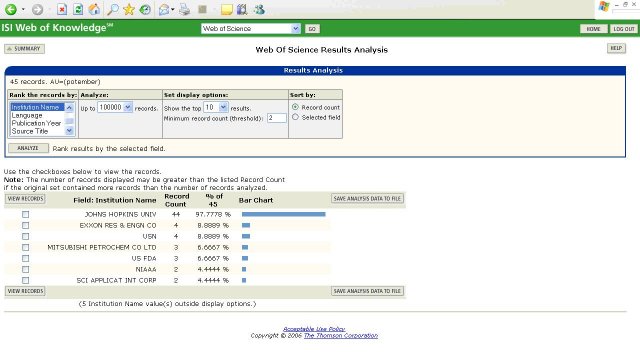
Figure 3: Web of Science Results Analysis by Institution Name
Web of Science also has a "related records" capability. Find out which authors are citing the same papers, etc.
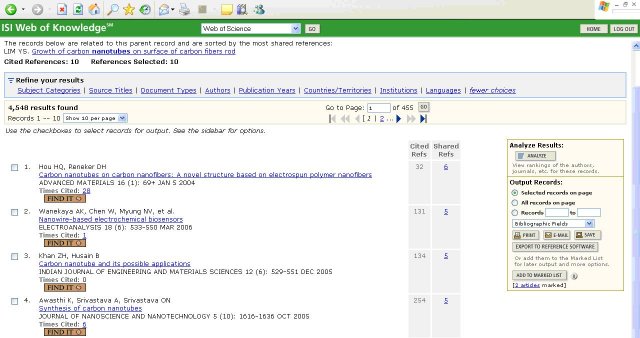
Figure 4: Related Records Results from Web of Science
Scopus has a "citation tracker" link that gives you a neat synopsis by date of how many citations were found in their database to a particular article or resource. It also has a "related documents" feature similar to WoS, that lets you see what other authors are citing the same title.
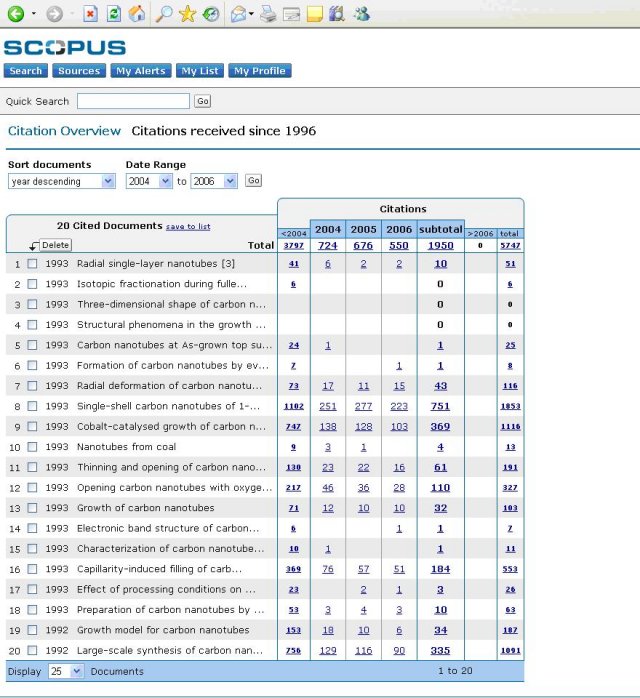
Figure 5: Scopus Citation Overview from Citation Tracker button
The "Related Documents" feature in Scopus gives you the option to find documents even on the web relating to the keywords or authors in a specific document.
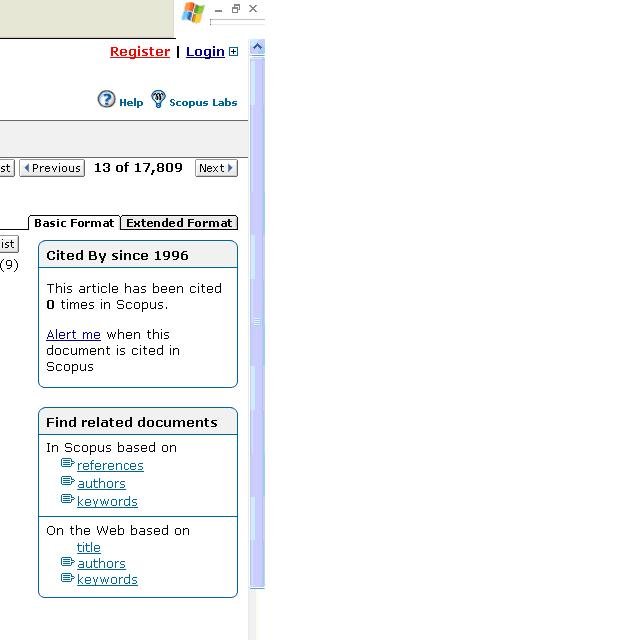
Figure 6: Scopus Related Documents Search Options
If you want to delve DEEPLY into the relationships between papers, authors, and citations, start using these related records features. Now if only they both would add visualization capabilities, but at this point we must use EXCEL or other tools for more "robust" data presentation. However, according to their link from the home page, Scopus Labs are working on just this feature, so I'm sure ISI is doing so as well.
Buyer Beware
There are some caveats from previous papers that I feel should be included in this review. Probably due to its expansive claims, the completeness of Scopus has been under particular scrutiny. In their Charleston Advisor review Deis and Goodman (2006) reiterated the conclusion from a year earlier that a significant number (10%) of important titles are missing issues.Dees (2006) suggests "puzzling gaps" and numeric inconsistencies in many areas of Scopus content and searches.
Abstracts are extremely useful in evaluating which titles to choose from an extensive list. Scopus "wins" in this area, due to its provenance from abstract databases. WoS mainly has abstracts only if provided by the author, although ISI has started to add them for articles from 1971 (Jacso 2005).
I reiterate that both of these products have tremendous value and numerous features, and that the pros, cons and costs must be evaluated by each institution.
Addendum
As this review was being written, ISI announced several enhancements to the Web of Science product coming in November 2006 as follows:- Citation Report - New, powerful citation analysis feature.
- Distinct Author Identification System - Find the right author, quickly.
- Full Author Names - Web of Science now captures full author names as they are listed in original articles.
Though the author could not get any specifics from ISI, there are several online training sessions scheduled for the first week in November about these upcoming features. They are listed in the ISI Web Base Training page (Thomson 2006e).
Scopus, on October 17th, announced an improvement in "the transparency of Scopus' content coverage," such as:
- Active vs inactive titles.
- Title history, such as title changes (this already is in WoS).
- Latest issues covered by Scopus.
References
Bakkalbasi, N. et al. 2006. Three options for citation tracking: Google Scholar, Scopus and Web of Science. BMC Biomedical Digital Libraries 3:7. [Online]. Available: http://www.bio-diglib.com/content/3/1/7 [October 2006].Burnham, J. 2006. Scopus database: a review. Biomedical Digital Libraries 3:1. [Online]. Available: http://www.bio-diglib.com/content/3/1/1 [Accessed: November 20, 2006].
Deis, L. F. & Goodman, D. 2005. Web of Science (2004 Version) and Scopus. The Charleston Advisor 6(3). [Online]. Available: {http://www.charlestonco.com/comp.cfm?id=43} [Accessed: December 7, 2005].
________. 2006. Update on Scopus (Reviewed November 2005). The Charleston Advisor 7(3). [Online]. Available: {http://charlestonco.com/comp.cfm?id=55} [Accessed: October 20, 2006].
Dess, H. 2006 Scopus. Issues in Science and Technology Librarianship 45 (Winter). [Online] Available: http://www.istl.org/06-winter/databases4.html [Accessed: November 20, 2006].
Fingerman, S. 2005. Scopus: Profusion and Confusion. Online 29(2):36-38.
Jacso, P. 2005. As We May Search--Comparison of Major Features of the Web of Science, Scopus, and Google Scholar Citation-Based and Citation-Enhanced Databases. Current Science 89(9):1537-1547. [Online]. Available: {http://choo.fis.utoronto.ca/fis/courses/lis1325/Readings/jacso.pdf} [Accessed: November 20, 2006].
LaGuardia, C. 2005. E-Views and Reviews: Scopus vs Web of Science. Library Journal.com. [Online]. Available: {http://lj.libraryjournal.com/2005/01/technology/e-views-and-reviews-scopus-vs-web-of-science/} [Accessed: November 20, 2006].
Scopus Info. 2006a. Content Coverage. [Online]. Available: {http://www.info.sciverse.com/scopus/scopus-in-detail/content-coverage-guide/sourcetypes} [Accessed: November 20, 2006].
________. 2006b. The Scopus Author Identifier. [Online]. Available: {http://www.info.sciverse.com/scopus/scopus-in-detail/tools/authoridentifier/} [Accessed: November 20, 2006].
Thomson Scientific. 2006a. ISI Web of Knowledge. [Online]. Available: http://www.scientific.thomson.com/support/recordedtraining/wos/ [Accessed: November 20, 2006].
________. 2006b. Recorded Training Sessions. [Online]. Available: http://www.scientific.thomson.com/support/recordedtraining/ [Accessed: November 20, 2006].
________. 2006c. The Thomson Scientific Journal Selection Process. [Online]. Available: {http://thomsonreuters.com/products_services/science/free/essays/journal_selection_process/} [Accessed: November 20, 2006].
________. 2006d. Web of Science. [Online]. Available: http://www.scientific.thomson.com/support/recordedtraining/wos/ [Accessed: November 20, 2006].
________. 2006e. Web Based Training. [Online]. Available: http://scientific.thomson.com/support/training/webtraining/ [Accessed: November 20, 2006].
| Previous | Contents | Next |
